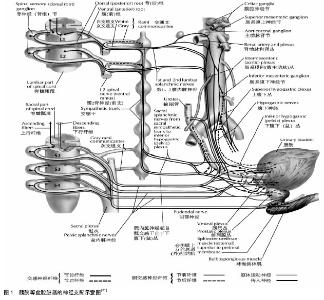| [1] Heald RJ, Husband EM, Ryall RD. The mesorectum in rectal cancer surgery-the clue to pelvic recurrence. Br J surg. 1982; 69(10): 613-616.
[2] Havenga K, Enker WE. Autonomic nerve preserving total mesorectal excision. Surg Clin North Am. 2002;82(5): 1009-1018.
[3] Kneist W, Junginger T. Long-term urinary dysfunction after mesorectal excision: a prospective study with intraoperative electrophysiological confirmation of nerve preservation. Eur J Surg Oncol. 2007;33(9):1068-1074.
[4] Petros M, John ES. Surgical anatomy of the retroperitoneal spaces, part IV: retroperitoneal nerves. The American Surgeon. 2010;76(3):253-262.
[5] Alsaid B, Bessede T, Diallo D, et al. Computer-assisted anatomic dissection (CAAD): evolution, methodology and application in intra-pelvic innervation study. Surg Radiol Anat. 2012;34(8):721-729.
[6] Stelzner S, Holm T, Moran BJ, et al. Deep pelvic anatomy revisited for a description of crucial steps in extralevator abdominoperineal excision for rectal cancer. Diseases of the Colon & Rectum. 2011;54(8): 947-957.
[7] Breukink SO, Pierie JP, HoV C, et al. Technique for laparoscopic autonomic nerve preserving total mesorectal excision. Int J Colorectal Dis. 2006;21(4):308-313.
[8] Fukunaga Y, Higashino M, Tanimura S, et al. Laparoscopic mesorectal excision with preservation of the pelvic autonomic nerves for rectal cancer. Hepatogastroenterology. 2007; 54(73): 85-90.
[9] Jayne DG, Brown JM, Thorpe H, et al. Bladder and sexual function following resection for rectal cancer in a randomized clinical trial of laparoscopic versus open technique. Br J Surg. 2005;92(9):1124-1132.
[10] Walters A. One is the loneliest number: a review of the ganglion impar and its relation to pelvic pain syndromes. Clinical Anatomy. 2013;26(7):855-861.
[11] He JH, Wang Q, Cai QP, et al. Quantitative anatomical study of male pelvic autonomic plexus and its clinical potential in rectal resection. Surg Radiol Anat. 2010;32(8):783-790.
[12] Karam I, Droupy S, Abd-Alsamad I, et al. Innervation of the Female Human Urethral Sphincter: 3D Reconstruction of Immunohistochemical Studies in the Fetus. European Urology. 2005;47(5):627-634.
[13] Clausen N, Wolloscheck T, Konerding MA. How to optimize autonomic nerve preservation in total mesorectal excision: clinical topography and morphology of pelvic nerves and fasciae. World J Surg. 2008;32(8):1768-1775.
[14] White WC, Xie HJ, Ventura S. Age-related changes in the innervation of the prostate gland. Organogenesis. 2013;9(3): 206-215.
[15] Lindsey I, Guy RJ, Warren BF, et al. Anatomy of Denonvillier’s fascia and pelvic nerves, impotence, and implications for the colorectal surgeon. British J Surg. 2000;87(10):1288-1299.
[16] Van Ophoven A, Roth S. The anatomy and embryological origins of the fascia of Denonvilliers: a medico-historical debate. J urol. 1997;157(1):3-9.
[17] Runkel N, Reiser H. Nerve-oriented mesorectal excision (NOME): autonomic nerves as landmarks for laparoscopic rectal resection. Int J Colorectal Dis. 2013;28(10):1367-1375.
[18] Takenaka A, Leung RA, Fujisawa M, et al. Anatomy of autonomic nerve component in the male pelvis: the new concept from a perspective for robotic nerve sparing radical prostatectomy. World J. Urol. 2006;24(2):136-143.
[19] Ganzer R, Stolzenburg JU, Wieland WF, et al. Anatomic study of periprostatic nerve distribution: immunohistochemical differentiation of parasympathetic and sympathetic nerve fibres. Eur. Urol. 2012;62(6):1150-1156.
[20] Bruns MT, Weber DJ, Gaunt RA. Microstimulation of afferents in the sacral dorsal root ganglia can evoke reflex bladder activity. Neurourol Urodyn. 2015;34(1):65-71.
[21] Yiou R, Laet KD, Hisano M, et al. Neurophysiological testing to assess penile sensory nerve damage after radical prostatectomy. J Sex Med. 2012;9(9):2457-2466.
[22] Maria AG, Claudio T, Raffaele C. Pain thresholds in women with chronic pelvic pain. Wolters Kluwer Health. 2014;26(4): 1-7.
[23] Onofrio T, Antonio SL, Emanuele S. Chronic pelvic pain in endometriosis: an overview. Clin Med Res. 2013;5(3):153- 163.
[24] Dellon AL, Wright EJ, Manson PN. Chronic pelvic pain after laser prostatectomy: treatment by resection of the perineal branches of the pudendal nerve. J Reconstr Microsurg. 2014; 30(8):547-550.
[25] Berkley KJ, Rapkin AJ, Papka RE. The pains of endometriosis. Science. 2005;308(5728):1587-1589.
[26] Wu GY, Sridhar S. Diagnostic and therapeutic procedures in gastroenterology: an illustrated guide. New York Springer. 2011;141(3):285-288.
[27] Casasola OA. Critical evaluation of chemical neurolysis of the sympathetic axis for cancer pain. Cancer Control. 2000;7(2): 142-148.
[28] Oh CS, Chung IH, Ji HJ, et al. Clinical implications of topographic anatomy on the ganglion impar. Anesthesiology. 2004;101(1):249-250.
[29] Dxion JS, Gosling JA, Canning DA, et al. An immunohistochemical study of human postnatal paraganglia associated with the urinary bladder. J.Anat. 1992;181(3): 431-436.
[30] Dxion JS, Jen PY, Gosling JA. Immunohistochemical characteristics of human paraganglion cells and sensory corpuscles associated with the urinary bladder. J.Anat. 1998;192(3):407-415.
[31] Machado CA. Atlas of human anatomy. Sixth edition. ELSAVIER. 2014. |

